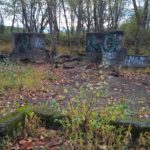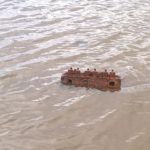Old Alder: Visit before it vanishes
The term “ghost town” in today’s time has evolved from its more literal interpretation to describe any small town that has been abandoned or vacated (except for Liberty, Washington’s only living ghost town). In fact, there’s a whole culture of folks dedicated to discovering and exploring ghost towns and their history. Most of the time, however, towns devoid of inhabitants have nowhere to grow but older. Not so for old Alder.
Tacoma is directly connected to Mount Rainier National Park via Washington State Route 7. The beautiful drive winds through east Pierce County, into and out of the Ohop Valley and along the Nisqually River to Alder Lake, a body of water made artificially larger after the construction of Alder Dam – the same structure that turned old Alder into a ghost town when the dam was built in 1944.
Primarily a logging and mining town, Alder was settled in the late 1800s and finally platted in 1904. Named for the predominance of alder trees surrounding the area, it boasted a population upward of 200 in its heyday. Though there wasn’t anything particularly special about Alder, it became a part of Washington State history when residents were told to evacuate in 1942 because the second Nisqually Dam Project would result in the town being forever submerged underwater.
In late summer and early fall when Alder Lake is drawn down to its lowest point of the year, visitors can literally walk where water once covered just weeks prior. Swimming area buoys, once floating on the surface, now rest half buried in the sand awaiting the return of recreational waters that come with the snowmelt in springtime. And when the lake is low enough, you can literally hike through history as the foundations and – if you’re lucky – artifacts of the old Alder townsite become exposed once more.
The easiest way to get there is to park at the eastern entrance to Sunny Beach Point just before Alder Cutoff Road. There’s plenty of parking room when the park is closed for the season. A short walk through the park on paved trails leads you right to a path at the swimming area that takes you out onto the lakebed. In late fall the ground is very solid, the plant life is abundant and if not for the landscape being dotted with waterlogged alder stumps you probably wouldn’t think that you were standing in the middle of a lake.
Just a few hundred yards from the swimming area is the highest point in Alder Lake. It’s an island only accessible by watercraft when the lake is full but nothing more than a small hill at the lake’s low point. It’s on this island that you’ll find the ruins of old Alder’s schoolhouse. A large stone foundation with two massive pillars indicating the entryway are all that remain of the town’s only educational facility.
Interestingly, when the town was flooded in 1944, only three of the original buildings were saved and relocated. One of them was the schoolhouse, which now serves as a community hall just outside the entrance to Alder Lake Park. Another building saved and relocated was the Presbyterian church which today sits very near the community hall (in the area that today is called Alder, hence the references to “old” Alder). A third building rescued was relocated further up the road closer to Eatonville.
After only a few minutes exploring, you’re likely to discover more building foundations and rusted out remnants of once-underground pipes connecting shops in the former business district of old Alder. Closer to the waterline you might find ladies shoes from a fashion era long since past or the engine block to a Model A Ford which might be peeking up from beneath the water’s surface. Old tires and unidentifiable pieces of rusty machinery can be found sparingly throughout the area and – again, if you’re lucky – the railroad trestle that once carried iron horses over Alder Creek through the middle of town.
I’ve seen pictures of pottery and dishware that previous explorers have uncovered at the old Alder townsite, and I have no doubt that more is waiting to be unearthed by amateur archaeologists. Just remember if you stop for a visit the next time you’re on your way to Mount Rainier, to leave anything you find in its place so it can be discovered anew by the next budding historian. Take only pictures and leave only footprints…lest the ghosts of old Alder be roused by your curiosity.
- A building foundation near the business district, possibly a storefront or small residence.
- Lengths of underground pipe that had connected the former buildings are now exposed and rusted out.
- Steps that once led from the schoolhouse to Alder’s business district.
- All that remains of the old Alder schoolhouse.
- The exposed railroad trestle that once crossed Alder Creek.
- The remnants of some old piece of machinery.
- Stones don’t line themselves up like that. Perhaps it was someone’s terraced garden?
- Leather boot of unknown age with no identifying markings, tags or logos.
- Old tire, mostly buried in the mud under Alder Lake.
- Rusted out engine block peeking up above the lake’s surface, waiting to be discovered.
- Presbyterian church that was built in 1904 and relocated to today’s Alder.
- The old Alder schoolhouse is now the community center further inland.














Pingback: Mount Rainier National Park – Where in the World is Marissa
We purchased a property here in Eatonville in 2021, just a block away from Lilly Dale Rd. We were told that our 1910 year old house was moved from the Alder Town as well. It is quite nice to live in a bit of history:)
Also, an old road goes through our 5 acres of property:)
Hi Richard! I, too, enjoy metal detecting with the thought of discovering some sort of historical artifact. What I’ve learned working with museum and historian colleagues is that they really try to dissuade “treasure hunters” from exploring historical sites with that intent. They would prefer to see a professional archaeological dig take place to uncover artifacts from the past. The problem is, there are rarely enough people or funding to make those things happen. I can’t approve or deny your question about searching the area with a metal detector, but I will say this…there are plenty of historical finds to be seen right on the surface when the lake is at its lowest point. And if you want to dig deeper, you’ll need permission from the property owner. Old Alder sits on Alder Lake Park land, which is owned by Tacoma Public Utilities. You can contact the park office at 360-569-2778.
I would like to metal detect for artifacts there in the spring. Is this going to be a problem with any organization or local residense. i would be happy to abide by rules and would appriciate any information pointing me in the right direction. I fish at mineral lake and it would be interesting locating historical artifacts.
Richard Slover
360-779-3931
My grandparents lived in National after the Alder Dam was constructed. My grandfather worked as a logger for Paul Anderson’s logging company. I believe it was in the mid-fifties. My grandmother worked for the library. My recollection is that most of the area has been reclaimed by nature. It was located before Ashford but I was too young to remember how far away it was. There was a sign that marked the road but last time I was out that way the sign was gone.
My father also talks of his home in National, being flooded as a result of dam construction. I haven’t quite been able to locate that site.
The church wasn’t moved, as far as I, a lifelong member, know. I can double check my 100 year history book that we put together as a church. Also, only the top story of the schoolhouse was saved. They relocated it onto a basement built in place at its current site. The Top story was the gym so it is one huge room.
I may have some history there too as we were community club members my whole life until a few years back, and I once wrote out a history of it I had gathered from elder locals. It’s a great building. I was married in it. If they still have yardsales or community pot lucks there it is worth stopping.
Probably the 3rd building you mention moving is the Hotes (pronounced Ho-Tess) temple in Eatonville (current Mason’s Hall and yogurt shop among other things). This is mentioned in the NW Room (Tacoma Public Library) archives as having been donated and moved from its site on the Nisqually river after the flooding. I do believe it was donated later, though, in about 1954, and the Masonic records, from what I’ve heard (but not read myself) don’t have the same story and they don’t believe it was in fact, moved. As it seems to be masonry covered in stucco or plaster, I would guess the Mason’s are right and it was built in situ at the current place.
And what Bob said is right. Many houses and buildings in the area were moved without any recorded history as families did it themselves. If you can find the hand bound old Alder History book that Mr. Sanders put together before he died, there are many almost unknown photos. I believe that’s where I saw the photos of the cars lived up along the old highway watching the floodwaters come in.
The old road is still there, on the other side of the island and trestle. If one parks at the first curve of Lillie Dale Rd (right off Mtn Hwy just South of the two main lake Parks), the road is underneath your feet as soon as you’re in the lake off the trail.
There were still cement posts and heavy gauge wire between them (old guardrails) along it when I was a kid, but I think they’ve disappeared.
Midway Creek is up by what was New Reliance, a ‘ghost Town’ of its own sort of. It was a very small logging camp trying to get going once upon a time but that history is very nearly completely lost.
National, huh? I’ve never heard of it…so it sounds like a good reason to learn more!
my mother lived in National that was right down the road.
The rest of the story is I put that engine block in Alder Lake near the house of then Robert Fife. I used it to moor my little 18foot tri sailboat near the shore. Also more than three buildings moved from the Alder site. I can think of several on my road alone. One has burned down and one is still standing on the Alder Mashell road and one at the entrance to Holiday Hills on the Midway creek Road.